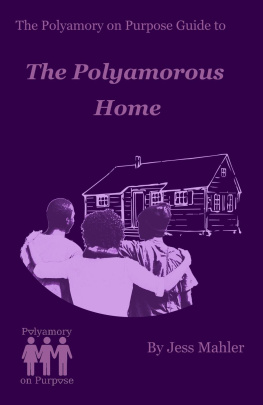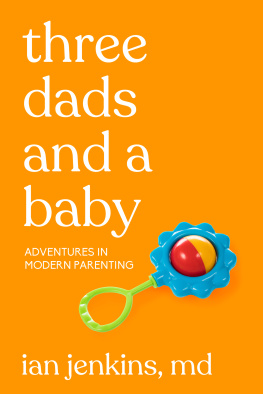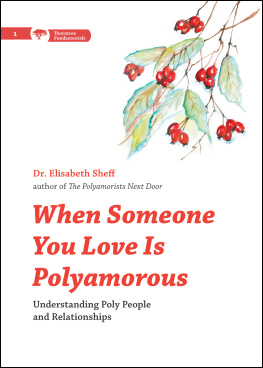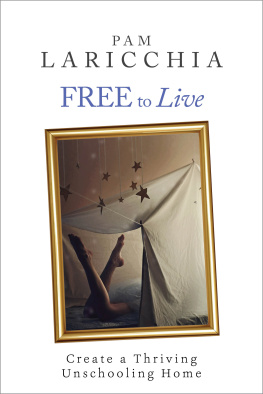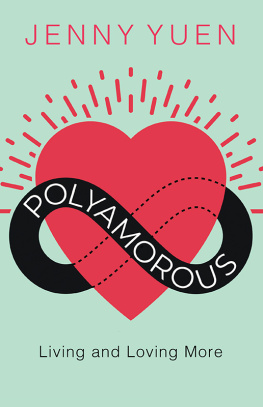The Polyamorous Home
by Jess Mahler
While every precaution has been taken in the preparation of this book, the publisher assumes no responsibility for errors or omissions, or for damages resulting from the use of the information contained herein.
THE POLYAMOROUS HOME
First edition. November 20, 2016.
Copyright 2016 Jess Mahler.
ISBN: 978-1540116307
Written by Jess Mahler.
10 9 8 7 6 5 4 3 2 1
Dedication
F or Alan M. With thanks.
Acknowledgements
I owe thanks to a number of people for helping make this book a reality.
To my beta readers for their insight and advice.
To the many people who have shared their experiences on my blog, on forums, and in private conversations.
To Ron Young and the Black & Poly crew for making me welcome and sharing their experiences both with polyamory and the way race can impact people's experiences of polyamory.
To the many folks of the Polyamory Leadership Network who answered questions about solo polyam and polyamory around the world.
To Noel Figart of The Polyamorous Misanthrope for letting me use one of her blog posts.
To Jade Jossen for sharing their experiences of polyamory activism in Italy and making polyam work outside the 'big three' living arrangements.
And especially to Michon Neal, my sensitivity reader, for helping make this book as inclusive as possible.
Introduction
O ne day I tweeted to ask people's thoughts and experiences of bathrooms in a polyam home. One response said, "Get a home with three bathrooms."
This may have been a joke. The person who tweeted it was a new follower, and I didn't know them very well. I hope it was a joke. There is a popular (and wrong) conception that polyamory is for the middle-class. Polyam homes aren't just for people who can afford a house with three bathrooms. They aren't just for people who live in places that have indoor bathrooms in every home. Polyam homes can be tiny apartments for solo polyam folk or apartment buildings taken over by polyam groups. They can be cottages in the wilderness or marble foyered brownstones in New York. This book covers a small fraction of the ways a polyam home can functionno book could cover all of them. There are simply too many ways we can structure (or unstructure if you prefer) our living situations. My goal is to give some ideas and options for meeting the challenges of polyam living while remaining accessible and relevant to polyam people from as many walks of life as possible.
Over the years I have spoken with polyam folk from all over the world. The insight they shared has helped a great deal in making this book as inclusive as possible. However, my experiences color the information and ideas I offer. Please take what works for you and ignore what doesn't.
Other Resources
I've been reading and writing about polyamory for a number of years, and the ideas I've learned and developed in that time have shaped my approach to building a polyamorous home. If you are new to polyamory, or if you are experienced with polyamory but looking for additional resources, you might want to check out:
More Than Two by Franklin Veaux and Eve Rickert
The Polyamorous Misanthrope
More Than Two
Designer Relationships by Michael A. Marks and Patricia Johnson
Poly Weekly
/r/polyamory
The forums at Polyamory.com
The Polyamorists Next Door by Dr. Elizabeth Sheff
PostModern Woman by Michon Neal and Louisa Leontidas
Solo Poly
PolySingleish
The Feeling Is Multiplied
Glossary
Entwine: Tying your life to someone else's. For instance, sharing bills, living together, or taking a class together. Related: entwinement
Raul and Paula are very entwinedthey live together and share a carbut they aren't ready to get a mortgage together.
Hierarchical polyamory: Form of non-monogamy where one relationship has power over other relationships.
We practice hierarchical polyamory because we need to protect our relationship.
Metamour: Your significant other's significant other.
Prue and Kev are metamoursthey are both dating Wallace.
Non-hierarchical polyamory: Form of non-monogamy where each the people in each relationship, and only the people in each relationship, define what the relationship will be. Sometimes uses the same terms as hierarchical polyamory, leading to confusion in forums and discussion groups.
We practice non-hierarchical polyamory because we trust our partners to do their best to meet our needs or to tell us if they can't.
Other significant other (OSO): someone your partner is in a relationship with.
Yes, I'm John's significant other. His other significant other is Marleen.
Marleen, John's OSO, surprised me with a card for my birthday.
Primary: Hierarchical polyamoryTerm used to indicate the relationship that sets terms other relationships need to abide by. Non-hierarchical polyamoryTerm used to indicate the relationship that is someone's first priority. Also the person/people in a primary relationship. Most often used for a couple who live together.
Hierarchical: My primary partner needs to approve my other polyamory relationships.
Non-hierarchical: My primary relationship takes most of my time and attention.
Polycule: a network of polyamorous relationships. Derived from 'molecule' because when you start diagramming polyamorous relationships it looks like drawings of molecules in a chemistry textbook. Polycule is usually used to refer to a specific person's or group's relationships.
Our polycule includes me, Dan, Greg, Dan's boyfriend Juan, and Greg's girlfriend Monique, who is also dating Juan.
Secondary: Hierarchical polyamoryTerm used to indicate the relationship needs to follow rules set by other relationships. Non-hierarchical polyamoryTerm used to indicate the relationship that is not someone's first priority. Also the person/people in a secondary relationship.
Hierarchical: Rick was my secondary partner, but Shauna vetoed him.
Non-hierarchical: When I'm with my secondary partners, they get all of my attention.
Living Arrangements
Three polyamorous living arrangements get talked about a lot:
a group living together
a couple who live together and have other partners living elsewhere
solo polyamorous folk who live alone
Occasionally someone mentions quads who live as two couples in separate homes.
The main part of this book is divided into three sections based on those oft-discussed living arrangements. This isn't the best format for a book on polyamorous homes, but I couldn't come up with anything better. (Mea culpa.)
I encourage you to think of these sections not as boxes intended to divide polyamorous relationships, but as buffet tables allowing you to choose what is most relevant to you. A triad where two people live together and a third stays with them on weekends will find both the group and couple sections useful. A solo polyam person with roommates will find most of what they need in the solo section, but may find some helpful things in the group section. Read and use what is useful to you, ignore what doesn't apply.
Alternative Living Arrangements
The "big three" living arrangements may get all the attention, but many other living options exist. Whether you group, network, hierarch-, solo, open, close, unstructure or any combination of the above, there is a living arrangement that suits you and your relationship(s). Often lack of money or other restrictions make your ideal living arrangement impossible. That's okay! There are lots of other options that can work, even if they aren't perfect.
The following is not a comprehensive list of polyamorous living arrangements. It should give you some idea of the variety of options available. Use these as inspiration to think "outside the box." Be creative figuring out which living arrangement will work best for you and yours.[1]
Next page
